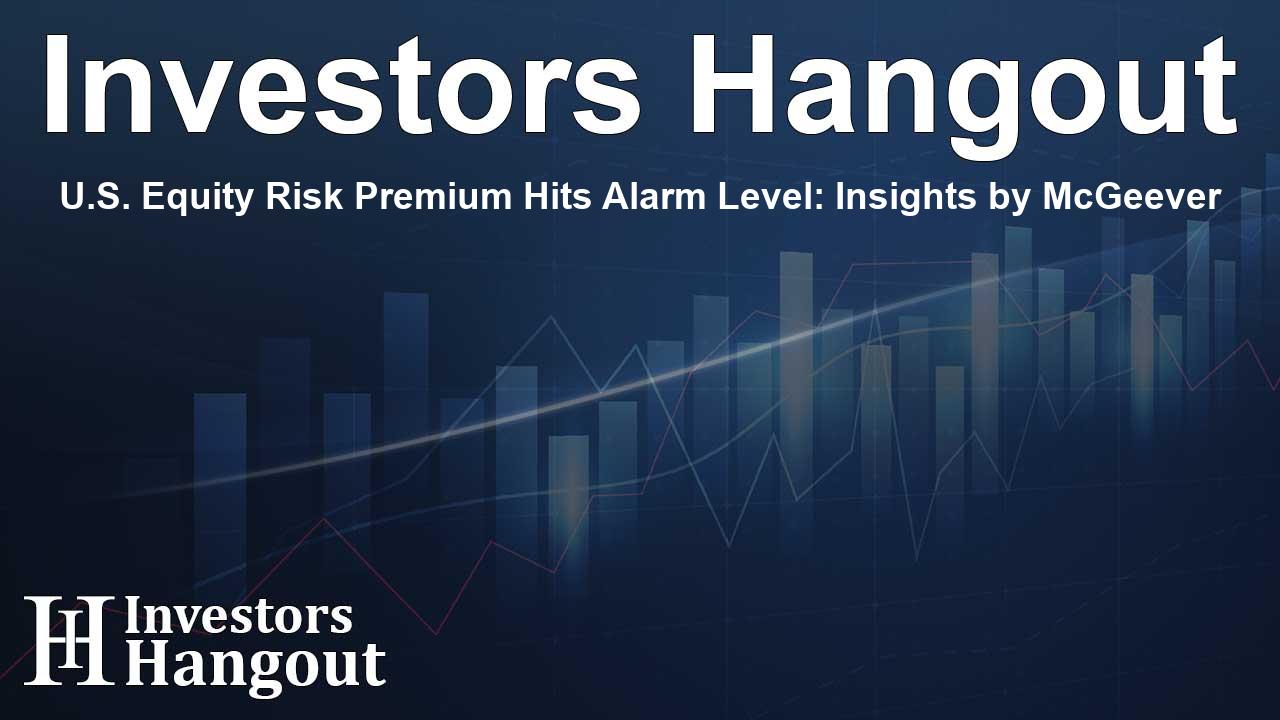U.S. Equity Risk Premium Hits Alarm Level: Insights by McGeever

Understanding the U.S. Equity Risk Premium Collapse
The U.S. stock market is currently experiencing a fascinating yet concerning trend with the equity risk premium (ERP). This premium, which measures the advantage investors receive for holding stocks over safer government securities, is facing a significant decline. As a crucial indicator, the ERP plays a vital role in guiding investor strategies and expectations in the financial markets.
The Dynamics of ERP Explained
The equity risk premium is essentially derived from the difference between the earnings yield of the S&P 500 index and the yield of 10-year Treasury bonds. Under typical circumstances, there is a positive premium that compensates investors for the risks associated with equity investing. However, the current market dynamics are anything but typical, as inflation fears and increasing bond yields prompt a re-evaluation of investment strategies.
Current Market Conditions
Long-term bond yields are rising contrary to expectations surrounding interest rate cuts by the Federal Reserve. The increased yield is troubling for investors, highlighting the precarious balance between risk and return in the market. The excitement around artificial intelligence and the dominance of major tech stocks have propelled stock valuations to historic highs, but this has also intensified concerns regarding sustainable growth.
Triggers for Portfolio Adjustments
As the ERP experiences a worrying decline, many investors are rethinking their stock-bond allocation strategies. Most financial experts anticipate that further increases in the 10-year Treasury yield will lead to continued pressures on the equity risk premium, potentially pushing it into unfavorable territory. In particular, a rise to around 5.00% could signal unhealthy dynamics for the S&P 500, suggesting that investments may need reevaluation.
Managing Investment Strategies Amidst Changing ERP
Understanding when to pivot between stocks and bonds is crucial for any investor, particularly when market indicators are shifting so rapidly. The complex interplay of various economic factors, including fiscal policies and geopolitical influences, adds layers of uncertainty to investment decisions. While some indicators may suggest it’s time to move toward bonds, determining the optimal timing for such adjustments remains challenging for many.
Historical Context of ERP Fluctuations
Historically, the ERP has reflected significant turning points in the market. For instance, March 2009 saw the ERP surge to formidable heights following the financial crisis, indicating a subsequent market low. Similarly, during the initial phase of the COVID-19 pandemic in April 2020, an increase in the ERP coincided with drastic changes in Treasury yields, marking another low in stock values.
Future Outlook on Equity and Bond Investments
Experts are closely monitoring the evolving dynamics of the ERP, with many believing that current pricing disparities are unsustainable. It may necessitate either a retraction in stock prices to align with increasing yields or a significant drop in yields to rationalize current equity valuations. As uncertainties linger surrounding U.S. fiscal and monetary policies, investors are advised to tread cautiously, balancing between potential market opportunities and inherent risks.
Frequently Asked Questions
What is the equity risk premium?
The equity risk premium (ERP) is the difference between the expected returns on equities and the returns on safer government bonds, reflecting the compensation investors expect for taking on additional risk.
Why is the ERP declining?
The ERP is declining due to rising Treasury yields coupled with high valuations in the stock market, leading to an unattractive risk-reward scenario for investors.
How do rising rates affect stock markets?
Rising rates typically lead to increased borrowing costs, which can strain corporate profits and lead investors to favor bonds over stocks, consequently pressuring stock prices.
What should investors do in a fluctuating ERP environment?
Investors may need to adjust their portfolios strategically, balancing between stocks and bonds while considering macroeconomic signals and personal risk tolerance.
Is the current market environment sustainable?
Many experts argue that the current market dynamics are unsustainable, requiring adjustments either in stock valuations or Treasury yields for market equilibrium.
About The Author
Contact Owen Jenkins privately here. Or send an email with ATTN: Owen Jenkins as the subject to contact@investorshangout.com.
About Investors Hangout
Investors Hangout is a leading online stock forum for financial discussion and learning, offering a wide range of free tools and resources. It draws in traders of all levels, who exchange market knowledge, investigate trading tactics, and keep an eye on industry developments in real time. Featuring financial articles, stock message boards, quotes, charts, company profiles, and live news updates. Through cooperative learning and a wealth of informational resources, it helps users from novices creating their first portfolios to experts honing their techniques. Join Investors Hangout today: https://investorshangout.com/
The content of this article is based on factual, publicly available information and does not represent legal, financial, or investment advice. Investors Hangout does not offer financial advice, and the author is not a licensed financial advisor. Consult a qualified advisor before making any financial or investment decisions based on this article. This article should not be considered advice to purchase, sell, or hold any securities or other investments. If any of the material provided here is inaccurate, please contact us for corrections.
